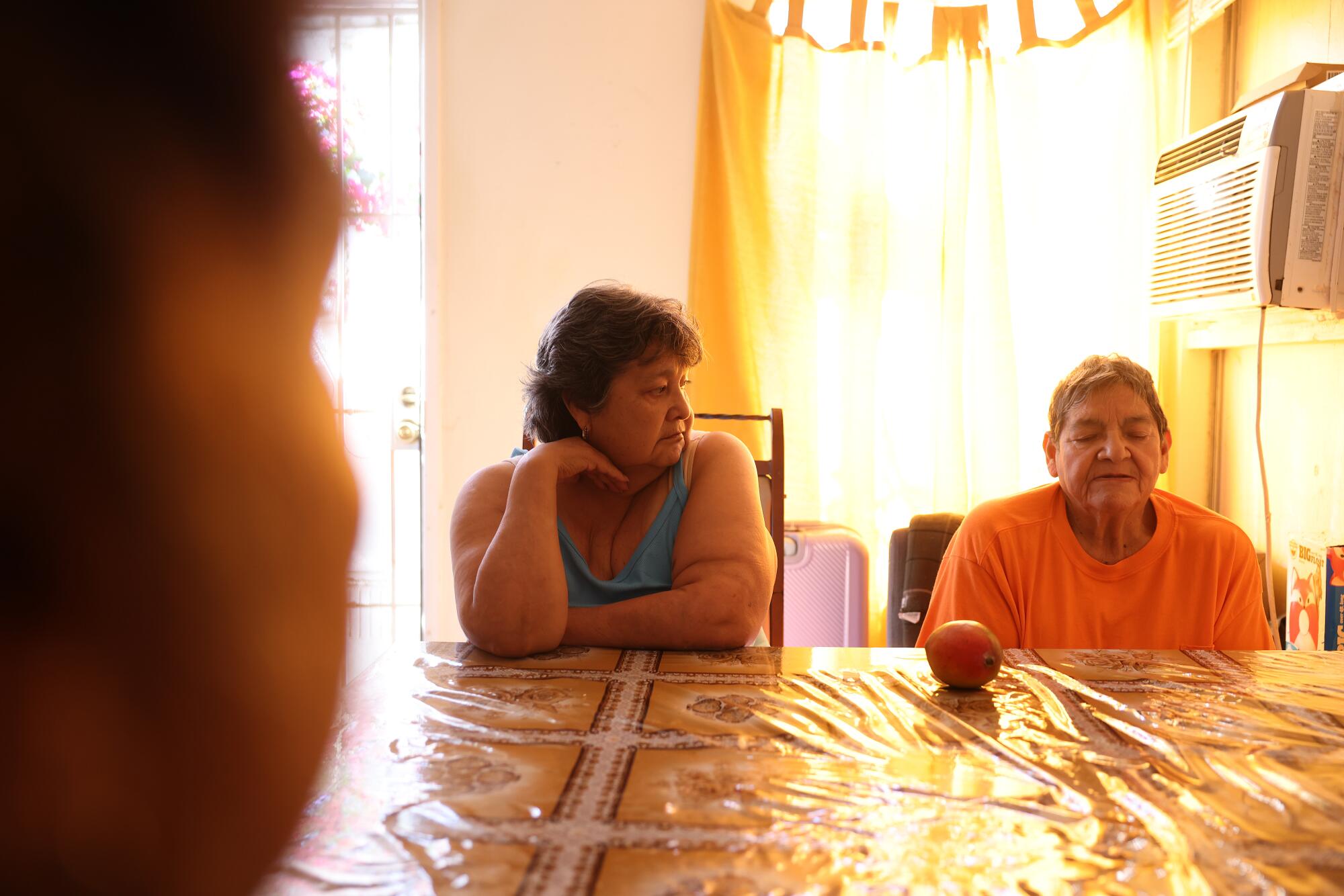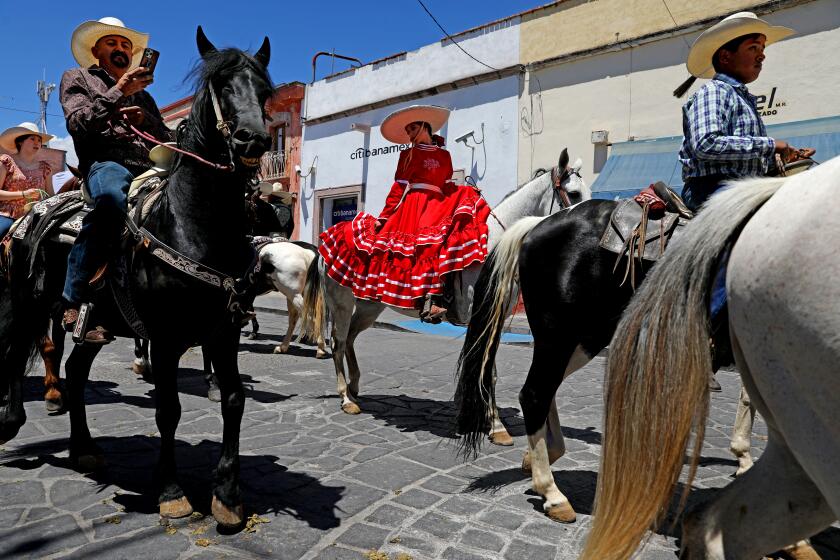
- Share via
If Maria del Carmen Díaz, 69, and Jose Carlos Silva, 67, had the retirement of their dreams, they’d own a house somewhere in the California desert. They would have a backyard where their eight grandchildren could play. Afternoons would be spent relaxing, Díaz knitting while her husband strummed guitar.
Instead, the couple rents a cramped back house in Pasadena, with little prospect that they will ever be able to stop working. Díaz cleans homes. Silva paints houses and landscapes yards. They get by on donations from a local food bank and help from their kids.

Many of their American-born peers are retiring. But Díaz and Silva have long been in the country without documentation. They never made enough money to save, and due to their immigration status they can’t receive Social Security benefits.
“If you don’t have papers, you can’t stop; you have to keep working,” said Silva, who crossed the border in 1994, fleeing an economic crisis in Mexico.
Most debates over illegal immigration — one of the biggest issues in this year’s presidential race — have focused on recent arrivals. But many of the roughly 10.5 million immigrants in the U.S. without authorization have been here for decades — holding jobs, having children and otherwise building lives.
A growing number are now hitting retirement age. And many are struggling.

In a recent national survey of 1,572 seniors from Mexico, 27% reported sometimes cutting back on meals because they couldn’t afford food. Fewer than 4% said they had pensions, and just 3% said they expected to have enough money to cover their basic expenses during retirement.
Some 70% are still working — compared with 19% of U.S. senior citizens.
“It was really startling to see how insecure their lives were,” said Nik Theodore, an urban planning professor at the University of Illinois Chicago, who carried out the study with the National Day Laborer Organizing Network, a nonprofit group that advocates for migrants. “There really is no safety net underneath these workers as they move to the later stages of life.”
Poverty among older people in general in the United States has jumped sharply in recent years, with more seniors working into their 70s and even 80s. The average American senior receives less than $2,000 in Social Security benefits each month.
But immigrants without legal work status are at a special disadvantage. They are not eligible to access Social Security or other crucial programs for the elderly, such as Medicare, despite the fact that many of them spent years paying into the plans.
As crime engulfs many Mexican states, immigrants who’ve saved to retire there are reevaluating ties to home — and whether returning is worth the risk.
Though some work under the table, many others use false identities and Social Security numbers, contributing payroll taxes to benefits they will never be able to claim.
That’s what Silva did during the years he spent washing vehicles at a Honda dealership, buffing cars with such intensity that he tore ligaments in his shoulders.
In 2022, undocumented workers paid a total of $40 billion into three programs — Social Security, Medicare and unemployment insurance — that they are barred from accessing, according to the Institute on Taxation and Economic Policy, a think tank in Washington.

“It’s not fair,” said Silva’s 36-year-old daughter, Erika, who was born in Mexico but is protected from deportation by Deferred Action for Childhood Arrivals, an Obama-era policy widely known as DACA. “They put in so much work. They deserve something back.”
Many migrants came to the U.S. to work so they could send money back home, propping up fragile economies and helping family members attend school, open businesses and visit doctors.
During her three decades in the United States, Gualberta Domínguez has sent tens of thousands of dollars to relatives in rural Mexico. She keeps a plastic bag overflowing with receipts from the money transfers she made each time she earned a paycheck — $200 in transfers one month, $400 another. The money went to her late mother’s medical bills, among other things.
Mexico received $63.3 billion in remittances last year, nearly all of it from migrants living in the U.S. In five Mexican states, remittances make up 10% or more of annual GDP.
At 73, Domínguez now spends mornings on the streets of Pasadena, searching trash bins for aluminum cans. The $600 or so she makes each month from selling them to recycling companies is all she has to live on. She doesn’t know what she would have done if her daughter hadn’t offered her a room in her crowded home, where Domínguez bunks with one of her grandchildren.

Domínguez is part of a new movement of migrants who are pushing the Mexican government to give back for their contributions to Mexico’s economy by making its new universal pension system available to its citizens living in the U.S. without documentation.
Under the program, Mexicans receive about $300 every two months. It’s not a life-changing sum, but it would be something, Domínguez said.
“I helped a lot,” she said. “It’s only fair that somebody help me.”
It’s not just drugs. Mexico’s cartels are fighting over avocados.
Former Mexican President Andrés Manuel López Obrador, who left office last month, has praised undocumented migrants as “living heroes” who help lift up poor parts of Mexico after being “forced to emigrate, to abandon their villages and their families.”
He said he believes migrants from Mexico should be eligible for the pension, but his government did not take steps to ensure that those living in the U.S. can enroll in the program.
President Claudia Sheinbaum, who, like López Obrador is a member of the leftist Morena party, has not addressed the issue.
Teresa Reyes was 39 when she left her small town in Michoacán. She assumed that in the U.S. she would be able to get ahead.

“I never thought I’d be a millionaire, but I hoped I would have a house and not want for anything,” she said.
She now calls the American dream “an illusion.”
Reyes, now 70, spent decades earning minimum wage in an apparel factory in Pasadena. Sometimes, her bosses paid her less than she was owed, knowing that because she lacked legal status, she had little recourse to complain.
“It wasn’t living,” Reyes said. “It was surviving.”
During the pandemic, Reyes was laid off. She searched for work, but said nobody wanted to hire an older woman who had limited use of her left shoulder after so many years of sitting hunched over sewing machines.
Today she lives in Pasadena with her 64-year-old sister, splitting a rented room for $500 a month.
“I feel sad,” Reyes said. “I feel like I failed for not achieving what I hoped for.”

Many migrants without legal status do jobs that are physically taxing. Their work opportunities tend to wane as they age.
Roman Perea, 62, a day laborer who lives in the desert town of California City, waits for work opportunities at a local Home Depot each morning. But he said potential clients are wary when they notice his gray hair.
“They only give jobs to the younger guys,” he said.
Perea deeply misses Mexico City, where he was born and raised. He longs for colorful Día de los Muertos celebrations, and the greasy taste of tripe tacos. He dreams of retiring there. But he has a big family in the U.S. His wife says she can’t imagine leaving their grandchildren.

It is a drama playing out in immigrant homes across the U.S.
Many migrants once dreamed of returning to their native countries in older age, but are now reluctant to leave because it would mean separating — perhaps forever — from family members for whom the U.S. is unequivocally home.
Others worry about violence or difficult economic conditions in their homelands.
Brothers Esequiel and Juan Serrano came to the U.S. in their 30s. Born in rural Puebla, they had been laboring since they were 6, tending to goats and cows and then toiling in cornfields. But it seemed that no matter how hard they worked, they would never earn enough to build homes for their families.
In the U.S. they managed to save, little by little. Esequiel sold corn and shaved ice from a cart he pushed around in Lancaster. His brother worked in construction.
They were able to buy small houses in California — and managed to purchase land in Mexico and build homes there.

Their parents are now in their 80s. The brothers dream of going back and living alongside them for their final years. But there is still a lack of well-paying work in their hometown. And Mexico’s public health care system can’t compete with Medi-Cal, the California insurance program open to low-income residents regardless of their immigration status.
It’s a paradox neither of them had anticipated.
“I never had the American dream,” said Juan, 59. “I just wanted to earn enough to built a life back home.”
But the U.S. had, in a way, trapped them. Esequiel’s daughter has given birth to his first grandson. Returning to Mexico would mean parting from him.
“Going back means forgetting everything here,” said Esequiel, 61. “I turn it over and over in my head: ‘Do I go or not?’”
More to Read
Sign up for Essential California
The most important California stories and recommendations in your inbox every morning.
You may occasionally receive promotional content from the Los Angeles Times.













